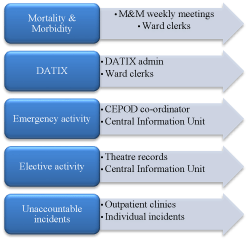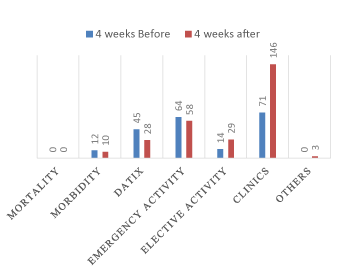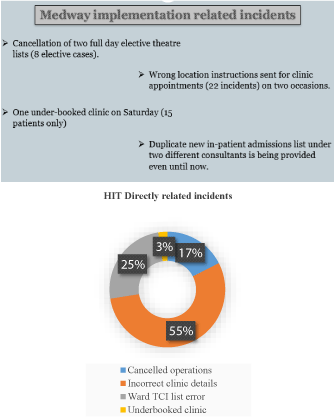From E-Oasis® to Medway®: An Observational Evaluation on Unintended Consequences in Surgical Patients Resulting from New Information Technology (IT) System Implementation in a Tertiary Care University Hospital in the United Kingdom
Muhammad S Sajid1*, Shehram Shafique2, Mohammed Albendar1, Christie Swaminathan1 and Krishna K Singh1
1Department of Digestive diseases & Gastrointestinal Surgery, Brighton & Sussex University Hospitals NHS Trust, The Royal Sussex County Hospital, Eastern Road, Brighton, West Sussex, BN2 5BE, United Kingdom2Department of Biomedical Sciences, St Georges University of London. Cranmer Terrace, London, SW17 0RE. United Kingdom
*Address for Correspondence: Muhammad S Sajid, Consultant GI Surgeon, Royal Sussex County Hospital, Eastern Road, Brighton, BN2 5BE. United Kingdom, Tel: +440-127-369-6955/ +440-789-166- 7608; E-mail: surgeon1wrh@hotmail.com
Submitted: 27 April 2020; Approved: 14 May 2020; Published: 16 May 2020
Citation this article: ajid MS, Shafique S, Albendar M, Swaminathan C, Singh KK. From E-Oasis® to Medway®: An Observational Evaluation on Unintended Consequences in Surgical Patients Resulting from New Information Technology (IT) System Implementation in a Tertiary Care University Hospital in the United Kingdom. Open J Surg. 2020;4(2): 029-032.
Copyright: © 2020 Sajid MS, et al. This is an open access article distributed under the Creative Commons Attribution License, which permits unrestricted use, distribution, and reproduction in any medium, provided the original work is properly cited
Keywords: Information technology; Health-care incidents; Risk related incidents
Download Fulltext PDF
Background: Health Information Technology (HIT) influences patient related incidents. Adoption or changing of HIT may lead to unanticipated and undesirable clinical incidents. This may well be associated with serious consequences where policies, regulations, and guidelines are few, less homogeneous and in some cases almost non-existent. Lack of provision of targeted HIT training to health-care professionals would proportionally result in increased clinical incidents.
Methods: Patients related clinical incidents such as mortality, morbidity, Datix (incident reporting tool), and any loss of elective or emergency activity in surgical department due to HIT related issues were collected prospectively for 4 weeks from the date of implementation of Medway® in the University Hospital and compared to same outcomes in previous 4 weeks.
Results: There were 205 clinical incidents before and 295 (p = 0.04) after the implementation of Medway®. There was no difference in morbidity, mortality and CEPOD theatre (emergency surgery) cancellation incidents. However, there was higher rate of elective (15 versus 29, p = 0.02) cases cancellation and number of patients (71 versus 146, p = 0.02) cancelled for clinic appointments. Fewer Datix related incidents were observed after Medway®. Medway® related incidents resulted in cancellation of two full day elective theatre lists (8 elective cases), wrong location for clinic appointments (22 incidents) on two occasions and one under-booked clinic on Saturday (15 patients only). Duplicate new in-patient admissions list under two different consultants was also reported for at least two months.
Conclusion: Introduction of new HIT is associated with increased health-care related incidents. Safety and trouble-shooting strategies should be implemented well in advance before changing HIT.
Introduction
The provision of safe healthcare in the contemporary era of rapidly evolving information technology is challenging and may well be posing significantly unique consequences for health-care consumers. The process of health-care provision in any modern health-care system should be associated with every possible measure to reduce errors and adverse events [1,2]. Health Information Technology (HIT) is used to collect, transmit, display, track or store patient data related to demographics, investigations, treatment strategies, clinic reviews and follow-up pathways [3]. Several developed countries such as the United States of America, United Kingdom (UK), Australia, and Canada have proactively encouraged the implementation and continuous upgrade of HIT to enhance patient safety [4,5].
The widespread utilization of HIT in health-care delivery undoubtedly brings several potential health-care benefits. But at the same time, snags with HIT can seriously disrupt the safe delivery of healthcare and substantially increase the likelihood of unique, new, often unforeseen errors that affect the safety and quality of clinical care resulting in patient harm [6-13]. It is imperative to understand the ways by which HIT related issues can disrupt health-care delivery posing threats to patient safety in order to reap its true benefits. The incidence of HIT related adverse and safety incidents are at risk of rising due to less homogenous policies, non-existent guidelines and lack of targeted training for end-users. Brighton & Sussex University Hospitals NHS Trust is a tertiary care referral center for major regional trauma network, for the management of upper and lower gastrointestinal cancer and it is equipped with all modern day multi-specialty care facilities. This Trust provides health care facilities to almost half million population on the South Coast of the England.
The objective of current study is to evaluate the unintended consequences of changing HIT system in a tertiary care University Hospital and its influence on patient safety with outcomes such as patient related incidents, system related incidents and any other work-place related incidents hampering work-flow and continuity of care.
Methods
This prospective observational study was conducted in a tertiary care center Brighton & Sussex University Hospitals NHS Trust when HIT system was changed from e-oasis® to an innovative broad-spectrum Medway®. The data for study cohort was collected prospectively and it was compared with the retrospective data of similar period before the implementation of Medway®. The data was collected related to the patients treated or investigated by the Digestive Disease Centre- surgical discipline. Major study variables included were the health care related incidents such as missed appointments in clinics, theatre list or operation cancellations, under-bookings or over-bookings of the patients for a clinical appointment and IT related errors responsible for delay in the provision of health-care. Main HIT related incidents were collected prospectively for 4 weeks from the implementation date of Medway® and compared to same outcomes in previous 4 weeks when e-oasis® was completely functional. Several data compiling systems and data collection resources were searched to collect data such as Datix record, CEPOD register, clinical governance folder, IT department data source CIU, computerized record of elective operative and non-operative activities as well as emergency operative activities (Figure 1). Other incidents which may or may not be directly influencing clinical care was also recorded (Figure 2). Five authors separately collected data of five domains that is Datix, Mortality & Morbidity record, emergency clinical activity, elective clinical activity and unaccountable incidents. Data was gathered on Microsoft Excel spread sheet and it was validated by all authors prior to the presentation in the departmental clinical governance meeting. The collected data was analysed using chi test to find the significant difference between both groups and p < 0.05 was set as cut off value for statistical difference. The statistical package SPSS® version 25 was used for analysis.
Results
There were 295 clinical incidents in 4 weeks after the introduction of Medway® compared to 205 clinical incidents for same periods when e-oasis® was functional (p = 0.04). There was no difference in mortality, morbidity and CEPOD cancellation or operational rates. However, elective operation cancellation rate (15 cases versus 29 cases, p = 0.02) and clinic appointment cancellation rate was significantly higher (71 patients versus 146 patients, p = 0.02) following the introduction of Medway®. Interestingly, the Datix incident reporting rate was significantly reduced during study period. Four major incidents were directly related to either dysfunctional Medway® or lack of optimum staff training to use Medway® (Figure 3). One of the most interesting incidents was the cancelation of 8 elective general surgical operations due to dysfunctional Medway which led the failure to retrieve blood results, group and cross match information and operational failure of anaesthetic equipment in operating room.
Discussion
Conclusion and lessons learnt
• Introduction of new HIT is associated with increased health-care related incidents. Safety and trouble-shooting strategies should be implemented well in advance before changing HIT.
• Because introduction of a new HIT system is associated with increased healthcare related incidents and therefore, the transition period should be closely monitored.
• An appropriate use of HIT is essential for optimizing the benefits of the HIT in reducing errors.
Limitations
• It is very difficult to correlate that the clinical incidents were directly due to change of HIT because of the presence of several confounding factors.
• Some relevant incidents related to change of HIT are difficult to estimate such as the delay in performance of surgical team during ward rounds and during emergency on-calls.
• There was general lack of awareness among IT professionals and health-care professionals that the change of HIT system or upgrade can affect patient safety and performance. Therefore, there is strong possibility of missing data which end-users failed to document or report.
• This is just an observational study and collected data has strong possibility of reporting and documentation bias.
Future implications
• Safe use of HIT is multi factorial, depending on competency, system quality, information quality, service quality, task-related stressor, training, organization resources, team-work, physical layout, and noise.
• Safety and trouble-shooting strategies should be implemented well in advance before changing HIT.
• An appropriate use of HIT is essential for optimizing the benefits of the health IT in reducing incidents.
- Institute of Medicine (US) Committee on Data Standards for Patient Safety; Aspden P, Corrigan JM, Wolcott J, Erickson SM. Patient safety: Achieving a new standard for care. National Academies Press (US). 2004. PubMed: https://www.ncbi.nlm.nih.gov/pubmed/25009854
- Vincent C. Patient Safety. John Wiley & Sons. 2011.
- Sittig DF, Singh H. Defining health information technology-related errors: new developments since to err is human. Arch Intern Med. 2011; 171: 1281-1284. PubMed: https://www.ncbi.nlm.nih.gov/pubmed/21788544/
- Morrison Z, Robertson A, Cresswell K, Crowe S, Sheikh A. Understanding contrasting approaches to nationwide implementations of electronic health record systems: England, the USA and Australia. J Healthcare Eng. 2011; 2: 25-42. https://bit.ly/3dJIp9L
- Rozenblum R, Jang Y, Zimlichman E. A qualitative study of Canada’s experience with the implementation of electronic health information technology. CMAJ. 2011; 183: 281-288. PubMed: https://www.ncbi.nlm.nih.gov/pubmed/21343262/
- Kim MO, Coiera E, Magrabi F. Problems with health information technology and their effects on care delivery and patient outcomes: a systematic review. J Am Med Inform Assoc. 2017; 24: 246-250. PubMed: https://www.ncbi.nlm.nih.gov/pubmed/28011595
- Bates DW, Gawande AA. Improving safety with information technology. New Engl J Med. 2003; 348: 2526-2534. https://bit.ly/3cxQ8rq
- IOM (Institute of Medicine). Health IT and patient safety: building safer systems for better care. Washington (DC): The National Academies Press. 2011. PubMed: https://www.ncbi.nlm.nih.gov/pubmed/24600741
- Sparnon E, Marella WM. The role of the electronic health record in patient safety events. PA-PSRS Patient Saf Advis. 2012; 9: 113-121.
- ECRI Institute PSO. ECRI Institute PSO DEEP DIVE: Health information technology. Plymouth Meeting, PA. 2012. https://bit.ly/3bxUxt7
- Sparnon E. Spotlight on electronic health record errors: papers or electronic hybrid workflows. Pa Patient Saf Advis. 2013; 10: 55-58. https://bit.ly/2yWEh7y
- ECRI Institute. Health information technology adverse event reporting: Analysis of two databases. 2014. Plymouth Meeting, PA. https://bit.ly/2LxfSZ7
- Castro G, Buczkowski L, Hafner J, Barrett S, Rasinski K, Williams S. Investigations of health IT-related deaths, serious injuries or unsafe conditions. The Joint Commission. Oakbrook. Terrace, IL. 2015. https://bit.ly/3dNM6vk





Sign up for Article Alerts